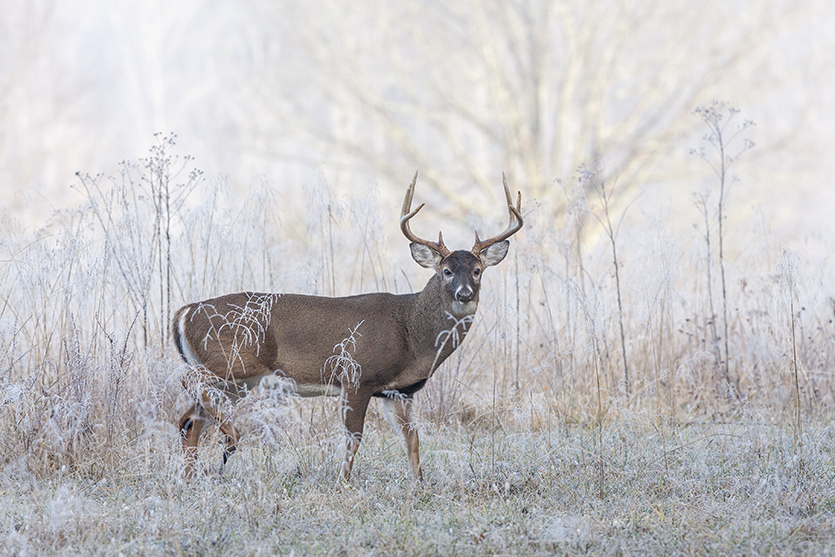
The Charleswood area is known for its scenic greenspace and wildlife. Among its wildlife are deer species which are commonly seen throughout this neighbourhood. In Manitoba we have two types of deer species: the mule deer and white-tailed deer.
The mule deer is typically larger than a white-tailed deer. From the face, a mule deer’s ears are wide at the base but taper to a point, whereas a white-tailed deer has rounder ears throughout. Of course, you can always spot a white-tailed deer by its namesake; its large fluffy white tail is used to signal to other members of the herd to stay alert when danger is nearby. Comparing this to the mule deer which has a white rump that is only partly covered by a small white tail with a black tip, will help you distinguish between the two species.
Deer are enchanting creatures to watch and many homeowners enjoy seeing them outside of their windows. However, as beautiful as they are, deer are known to cause damage to landscaped lawns and vehicles. Here are some deer-friendly tips to stay safe and to help protect your property.
Safety
In areas such as RidgeWood West where there are high deer populations, it’s not uncommon to see a deer crossing the road. Because of this, it’s crucial to stay alert and to drive cautiously especially during dusk and dawn when they are seen most. Deer are also known to become more active during their breeding season which is between October and late November.
If a deer does attempt to cross the road, be sure to slow down, dim your headlights and honk your horn to scare it away from traffic. Avoid swerving on the road to prevent a collision and brake hard if there isn’t a vehicle following close behind.
To alert other drivers of a deer crossing, turn on your flashing hazard lights - if you see one deer, it’s likely that there are others nearby. If it is dark outside and there isn’t any oncoming traffic, be sure to turn on your high beams to see potential deer from afar.
Deer-friendly lawns
Deer wander into yards looking for food because modern neighbourhoods often mimic their foraging areas with open lawns and tree-lined spaces. Planting plenty of trees, spreading shrubs and meadow plants in high quantities will avoid damage to your greenery by encouraging the deer to lightly graze over multiple plants rather than only munching on one.
To keep the deer guessing, try having plants they prefer such as hostas next to deer resistant plants such as Russian sage. This way, the deer won’t be able to get the full plant without encountering one that they don’t like. This will encourage them to move on to the next easy-to-reach meal and in turn, protect your plants from being overeaten.
Protecting your property
Although the main strategy should be to have plenty of greenery in a lawn to prevent plants from being overeaten, sometimes incorporating harmless deterrents are necessary when protecting new plants and tender growth.
Landscaping a yard by using different elevations can go a long way to help protect your plants from deer. Since deer don’t enjoy going up slopes or down steep areas they will likely find different areas to graze. If you have potted plants, it’s best to keep them on decks or on porches that require going up or down steps to reach them.
Mesh can also be used to create a physical boundary between plants and deer, allowing them to grow untouched.
Another option is to hang bars of soap on strings from trees or on large shrubs. This deters deer because they don’t like the smell of soap whether it’s wrapped or unwrapped. The soap bars can also be attached to stakes and placed within 10 to 15-foot intervals along a garden or property line.
Other effective ways of keeping deer away from certain areas is by setting a stake in the ground and placing an upside down bucket on top to create a lazy scarecrow or by hanging wind chimes in trees to generate unexpected noise.
Most of these methods are simple and don’t require much time. However, since deer are quite smart and can quickly adapt, it’s best to keep rotating between these techniques so they don’t become too comfortable.
While some might find the presence of deer in their community and the potential damage they can cause frustrating, it’s important to remember, that many species that were once abundant in numbers are now extinct. Take the passenger pigeon for example, this species was once one of the most common birds in North America, with three to five billion filling the skies. Then their numbers began to rapidly decline in the 19th century until the last one died in 1914, marking their extinction.
If history has taught us anything, it’s not to take any animal for granted. Some people may not like deer in their yards but instead of discouraging them, we could instead focus on how we can peacefully co-exist and enjoy their presence in our communities.